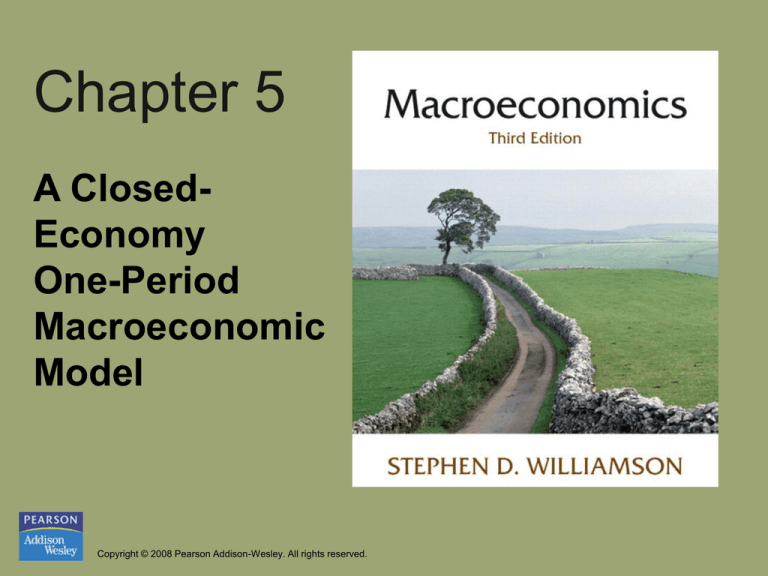
Chapter 5
A ClosedEconomy
One-Period
Macroeconomic
Model
Copyright © 2008 Pearson Addison-Wesley. All rights reserved.
Chapter 5 Topics
• Introduce the government.
• Construct closed-economy one-period
macroeconomic model, which has: (i)
representative consumer; (ii) representative firm;
(iii) government.
• Economic efficiency and Pareto optimality.
• Experiments: Increases in government spending
and total factor productivity.
Copyright © 2008 Pearson Addison-Wesley. All rights reserved.
5-2
Government
• Provide public goods, G, financed by lump-sum
taxes, T, on consumers or firms.
• Government budget is balanced (no deficits).
–G=T
Copyright © 2008 Pearson Addison-Wesley. All rights reserved.
5-3
Closed-Economy One-Period
Macroeconomic Model
•
•
•
•
•
Representative Consumer
Representative Firm
Government
Competitive Equilibrium
Experiments: What does the model tell us are
the effects of changes in government spending
and in total factor productivity?
Copyright © 2008 Pearson Addison-Wesley. All rights reserved.
5-4
Competitive Equilibrium
• Representative consumer optimizes given
market prices.
• Representative firm optimizes given market
prices.
• The labor market clears.
• The government budget constraint is satisfied, or
G = T.
Copyright © 2008 Pearson Addison-Wesley. All rights reserved.
5-5
Income-Expenditure Identity
In a competitive equilibrium, the incomeexpenditure identity is satisfied.
Copyright © 2008 Pearson Addison-Wesley. All rights reserved.
5-6
Equation 5.2
Copyright © 2008 Pearson Addison-Wesley. All rights reserved.
5-7
Equation 5.3
Copyright © 2008 Pearson Addison-Wesley. All rights reserved.
5-8
Figure 5.2A The Production Function
and the Production Possibilities Frontier
Y = z F (K, N)
Copyright © 2008 Pearson Addison-Wesley. All rights reserved.
5-9
Figure 5.2B The Production Function
and the Production Possibilities Frontier
Copyright © 2008 Pearson Addison-Wesley. All rights reserved.
5-10
Figure 5.2C The Production Function
and the Production Possibilities Frontier
Copyright © 2008 Pearson Addison-Wesley. All rights reserved.
5-11
Production Possibility Frontier
• Describe what the technological possibilities are for the economy
as a whole, in terms of the production of C goods and l, given z,
G, h.
• Points in the shaded area and on PPF are technologically feasible
for the economy. Points on AB are not feasible since all
consumption goods produced are taken away by government,
nothing left to private consumption.
• Captures the tradeoff between C and l that the available
production technology makes available to the representative
consumers in economy.
Copyright © 2008 Pearson Addison-Wesley. All rights reserved.
5-12
PPF - continued
• The slope of PPF = MRT l , C
• MRT l , C : marginal rate of transformation of
leisure into consumption, the rate at which
leisure can be converted technologically into
consumption goods through work.
• MRT l , C = - MPN = w
Copyright © 2008 Pearson Addison-Wesley. All rights reserved.
5-13
Figure 5.3 Competitive
Equilibrium
Copyright © 2008 Pearson Addison-Wesley. All rights reserved.
5-14
Equation 5.6: Key Properties of
a Competitive Equilibrium
At equilibrium, facing the same market price, the rate at which the consumers
are willing to trade l for C is the same as the rate at which the firms are willing
to convert l into C by using production technology.
Copyright © 2008 Pearson Addison-Wesley. All rights reserved.
5-15
Pareto Optimality
• A competitive equilibrium is pareto optimal if
there is no way to rearrange production or to
reallocate goods so that someone is made better
off without making someone else worse off.
• Q: suppose there exists a social planner, who
care about welfare of consumers, firms, and
government in total, whether the CE obtained
before is also socially optimal?
Copyright © 2008 Pearson Addison-Wesley. All rights reserved.
5-16
Solve for the PO
• A social planner chooses C and l, given
production technology for converting l into C, to
make consumers as well off as possible.
• That is, he chooses consumption bundle on or
within PPF and that is on the highest possible IC
for consumers.
Copyright © 2008 Pearson Addison-Wesley. All rights reserved.
5-17
Figure 5.4 Pareto Optimality
PO allocation is point B, where
IC is tangent to PPF.
Slope of IC
= -MRS l, C
Slope of PPF = -MRT l, C
Copyright © 2008 Pearson Addison-Wesley. All rights reserved.
5-18
Equation 5.6: Key Properties of
a Pareto Optimum
• In this model, the competitive equilibrium and
the Pareto optimum are identical, as
Copyright © 2008 Pearson Addison-Wesley. All rights reserved.
5-19
First and Second Welfare
Theorems
• First Welfare Theorem: Under certain conditions, a
competitive equilibrium is Pareto optimal.
• Second Welfare Theorem: Under certain conditions, a
Pareto optimum is a competitive equilibrium.
• Application: if CE is also PO, solve for the market
outcomes could be an easy way to solve social
planner’s problem.
Copyright © 2008 Pearson Addison-Wesley. All rights reserved.
5-20
Effects of an Increase in G
• Essentially a pure income effect
• C decreases, l decreases, Y increases, w falls
Copyright © 2008 Pearson Addison-Wesley. All rights reserved.
5-21
Figure 5.6 Equilibrium Effects of an
Increase in Government Spending
Copyright © 2008 Pearson Addison-Wesley. All rights reserved.
5-22








